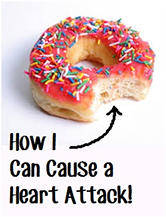How a Donut Can Cause a Heart Attack

It has been commonly accepted in the medical community for years that individuals with uncontrolled diabetes are at increased risk for cardiovascular disease. But the question to ask is why. And does it should it matter to you if you’re not diabetic?
For years we have measured LDL-Cholesterol (most people call this the bad cholesterol) as a means of assessing heart attack risk. But did you know that more than 50% of heart attacks happen in people with normal cholesterol levels? Despite 25% of Americans taking cholesterol lowering statin medications (which can be pricey!) the rate of heart attacks increases on an annual basis1. Researchers have turned their focus to other potential causes. Their preliminary findings? Food and lifestyle based inflammation. So how can a donut cause a heart attack? Let’s look at what happens in our body when we eat a donut:
Our bodies were designed to keep a tight reign on blood sugar control. The point of having glucose in the blood is to provide the body and cells with a quick source of energy if necessary. Our bodies need this blood sugar to stay in a well defined range. Too little blood sugar and our cells can’t receive energy in a timely manner (especially if this happens for a prolonged period of time) we can develop symptoms ranging from confusion, dizziness, and headaches to trembling, pounding heart, passing out, and can even go into a coma. Too much blood sugar and several of our body tissues that are especially sensitive to elevated blood sugar levels become damaged (some researchers believe irreparably) such as our kidney, our nerves (especially in our hands and feet), and certain cells in our eyes. Our bodies are equipped with very advanced regulatory methods to keep blood sugar within safe ranges.
Let’s pretend we’re eating a donut. As we chew, the saliva in our mouth contains enzymes which begin breaking carbohydrates down into individual glucose molecules. This process is completed in the stomach with the aid of stomach acid. The digested food in our stomach is released into our small intestine where the already released glucose molecules are quickly absorbed through our intestinal cells and enter the blood stream. This causes a rise in the glucose levels in our blood stream and can result in hyperglycemia (elevated blood sugar). Our body knows that these elevations in blood sugar will damage our sensitive tissues like our kidneys, eyes, and nerves, so it stimulates the pancreas to release a hormone called insulin. Insulin’s job is to attach to insulin receptors on cells and instruct the body to bring specialized glucose transporters to the cell surface so that glucose can be absorbed into the cell where it is used or stored for energy. If the cells do not need energy they will reject the glucose to prevent it from messing up their cellular processes. When this happens the blood sugar is converted into fat tissue and stored in adipose cells because the body needs to protect the kidney, eyes, and nerves from continued elevations of blood sugar.
This increase in fat tissue isn’t the only reason that eating donuts regularly can cause heart attacks. According to Dr. Lundell, a world-renown heart surgeon, this impact in blood sugar has a much stronger direct impact on the cause of heart attacks. When blood sugar levels are high the glucose molecules can attach to various proteins found naturally in your blood which can then damage blood vessel walls. This damage promotes an immune response and results in inflammation in the blood vessel walls. Think of these glucose-modified proteins as acting as sandpaper on the sensitive tissue lining of the blood vessels. If you were to rub sandpaper on sensitive skin it would become red and irritated. This triggers an immune response and results in inflammation. Inflammation in turn encourages cholesterol to accumulate in the lining of our blood vessels and arteries and to begin plaque build-up1. Now think about it: if elevations in blood sugar cause an effect similar to rubbing sandpaper on our arteries, and the traditional American diet is based in simple carbohydrates, then we’re essentially rubbing our arteries raw several times a day. That sounds like a horrible plan for avoiding heart attacks.
So what can we do to protect these sensitive tissues from damage and cholesterol accumulation? First, begin by making sure that your cells need energy. How do we do that? We use up some of the energy in our cells. That’s why exercise is one of the best ways to control and bring down blood sugar levels. If your cells are hungry there is a place for that energy to go. But let’s face it. We can’t outrun our forks. That brings me to the second, more simple method: avoid the foods that will spike our blood sugar. These are foods that contain carbohydrates that are easily broken down. Absorbing carbohydrates is very easy for the body so if you are choosing carbohydrates that are easily broken down (referred to as ‘simple’ carbohydrates) then your blood sugar will rise quickly. If your body has to work harder to break down the carbohydrates it will take longer to break the carbohydrates down and our blood sugar isn’t easily spiked. Complex carbohydrates are found in things like fruit (except for banana, pineapple, and papaya), whole grains, beans, and many vegetables.
So let’s focus this month on reducing the amount of simple carbohydrates you eat. Not sure what these look like? Try our 21 day challenge. You’ll be eliminating these simple carbohydrates for 21 days. Let’s give those arteries a rest!
- (2012, March 1). World Renown Heart Surgeon Speaks Out on What Really Causes Heart Disease. Retrieved from http://preventdisease.com/news/12/030112_World-Renown-Heart-Surgeon-Speaks-Out-On-What-Really-Causes-Heart-Disease.shtml.
Dallas
3800 San Jacinto
Dallas, TX 75204
(214) 827-8777
Driving DirectionsHours:
Monday, Wednesday,
Friday: 8:00 a.m. - 11:00 a.m.
Tuesday: 4:00 p.m. - 7:00 p.m.Grapevine
823 Ira E. Woods Avenue
Grapevine, TX 76051
(214) 827-8777
Driving DirectionsHours:
Thursday: 1:30 p.m. - 5:00 p.m.






